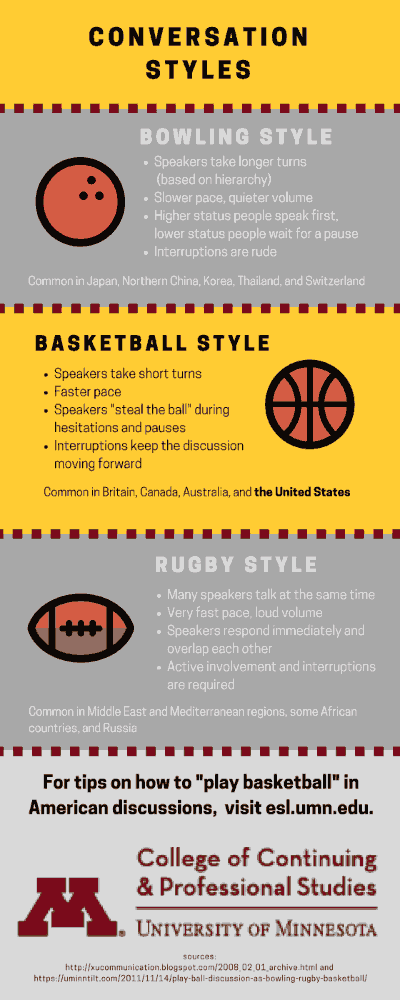Conversation Styles
Discussion styles in different cultures can be compared to playing sports. How people participate in discussions may vary depending on the topic, setting, age, gender, and personalities of the participants, but in the United States conversations are usually similar to playing basketball.
(Read a text only version of this graphic.)
How to Talk in a "Basketball Style"
- Keep your comments and questions short.
- Be ready to jump into the discussion. See "Phrases to Enter a Discussion" below for ways that you can "steal the ball" when someone else pauses or hesitates.
- Remember that other people might interrupt you when you pause or hesitate. That's okay!
- Use strategies to help you "keep the ball" longer. See "Ways to Avoid Interruption" below.
Useful Discussion Phrases
Here are 5 ways to make comments in class, with students demonstrating examples of each one.
Other Discussion Phrases
The following tips and phrases can be used in or out of the classroom.
How to make comments
Compliment another person’s comment and explain why you found it interesting or useful.
- That’s a really good point because…
- I’m glad you mentioned that because…
- It’s interesting you brought that up because...
Build on what someone else said. Make it clear how you are extending their idea.
- I’d like to add to that…
- I want to build on what ____ said…
- I have something to add to that...
Make a comment that directly relates to the course objectives, themes, or main topics.
- This really connects to the theme of this unit by…
- One of our course objectives is…
- I think this relates to our course topic because...
Bring up a related concept from this class or another class.
- We talked about this in my ____ class…
- We read something about this in another class I took…
- Last semester I read an article about this...
Summarize other comments by making a connection between what they said.
- It sounds like we all agree that…
- It seems that some of us think… while others argue…
- It sounds like a few people think… and other people think...
Phrases to enter a discussion
- Let me just say…
- Sorry to interrupt, but…
- I'd like to say…
- I have a question.
- If I could say something here…
Ways to avoid interruption
Phrases to help keep your turn in a discussion:
- There are two points I'd like to make.
- I have a couple of questions.
- I have a comment and a question.
- Two things. First…
What can you do if someone interrupts you? This short video on "Dealing with Interrupters" explains three steps:
- Make direct eye contact
- Use a hand gesture
- Say "please, let me finish"
[University of Minnesota students: to access the video click "Sign in" > click "Sign in with your organization portal" > type "umn.edu" > enter your internet ID and password.]
Phrases of agreement
- That's a good point.
- I totally agree.
- Right. I think…
- Exactly!
Phrases of disagreement
- I see what you mean, but…
- You have a point, but…
- But what about…?
- Yes, but on the other hand…
- I wouldn't say that…
How to ask for clarification
- Sorry, I didn't catch that.
- Could you repeat that?
- Can you explain that?
- What do you mean by…?
- I didn't understand the part about…
- Are you saying…?
How to ask for more information
- What did you mean when you said…?
- Could you be more specific about…?
- Could you give an example of that?
- Can you say more about…?
5 Ways to Buy Time in Discussions
Watch students demonstrate 5 ways to gain a little more time to think and participate in a discussion.
1. Have some general phrases ready to help you jump into the discussion.
- I have something to add to that…
- I’d like to add something…
- Going off of what she said…
2. Use body language to show you have something to say and want to jump in to the discussion.
- Make eye contact with the leader of the discussion
- Slightly raise your hand or finger
- Open your mouth like you’re going to say something
- Sit up straight and lean forward
3. Use hesitation phrases to give yourself a little time to think of an answer.
- Hmmm, that’s a good question…
- Let’s see, that’s a tough one…
- I’m not sure, let me think about that…
4. Ask a clarifying question.
- What did you mean by…
- Could you explain that more?
- I’m not sure what ____ means…
5. If you’re working in a smaller group, you can ask for time to write some notes.
Active Listening
During discussions (or conversations) in the US, we expect people to actively listen. This video explains some simple words you can say to show you are paying attention during discussions.
Additionally, you should use body language to pay attention during discussions. This video shows how to smile, nod, and make eye contact to show you are actively listening.
A Discussion Demonstration
The video below shows an example of students having a discussion. Watch the phrases they use to agree, disagree, interrupt, and jump into the discussion. In the second half of the video, the instructor explains useful phrases for participating in a discussion.
Practice
To work more on discussion strategies and identify ways to practice, you can make an appointment for a consultation with Student English Language Support.
You can also take ESL courses to improve your participation and discussion skills. Some good options are:
- ESL 3006 English for Business Interactions
- ESL 3502 Academic Listening and Speaking
- ESL 3602 Speaking for Academic Purposes

